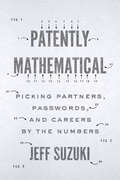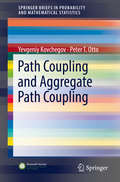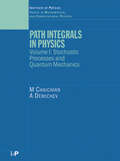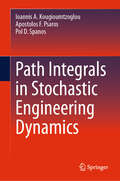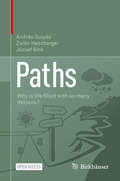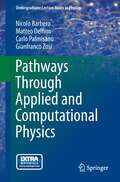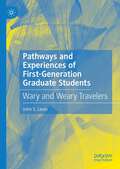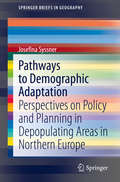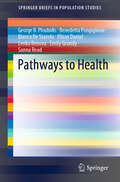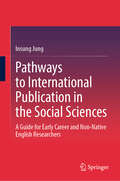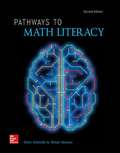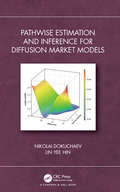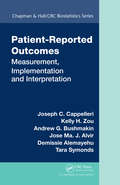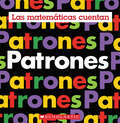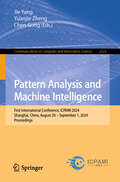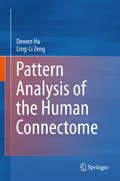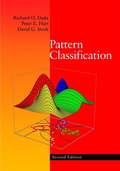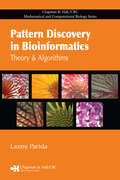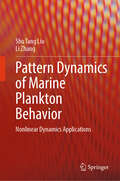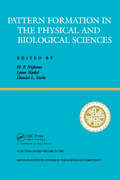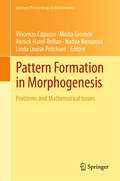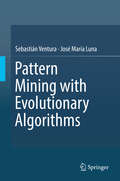- Table View
- List View
Patently Mathematical: Picking Partners, Passwords, and Careers by the Numbers
by Jeff SuzukiFascinating facts and stories behind inventions based on mathematics—from search engines to streaming video to self-correcting golf balls. How do dating sites match compatible partners? What do cell phones and sea coasts have in common? And why do computer scientists keep ant colonies? Jeff Suzuki answers these questions and more in Patently Mathematical, which explores the mathematics behind some of the key inventions that have changed our world.In recent years, patents based on mathematics have been issued by the thousands—from search engines and image recognition technology to educational software and LEGO designs. Suzuki delves into the details of cutting-edge devices, programs, and products to show how even the simplest mathematical principles can be turned into patentable ideas worth billions of dollars. Discover:• whether secure credit cards are really secure• how improved data compression made streaming video services like Netflix a hit• the mathematics behind self-correcting golf balls• why Google is such an effective and popular search engine• how eHarmony and Match.com bring couples together, and much moreCombining quirky historical anecdotes with relatable everyday examples, Suzuki makes math interesting for everyone who likes to ponder the world of numerical relationships.Praise for Jeff Suzuki’s Constitutional Calculus“An entertaining and insightful approach to the mathematics that underlies the American system of government.” —Mathematical Reviews“A breath of fresh air. . . . A reaffirmation that mathematics should be used more often to make general public policy.” —MAA Reviews
Path Coupling and Aggregate Path Coupling (SpringerBriefs in Probability and Mathematical Statistics)
by Yevgeniy Kovchegov Peter T. OttoThis book describes and characterizes an extension to the classical path coupling method applied to statistical mechanical models, referred to as aggregate path coupling. In conjunction with large deviations estimates, the aggregate path coupling method is used to prove rapid mixing of Glauber dynamics for a large class of statistical mechanical models, including models that exhibit discontinuous phase transitions which have traditionally been more difficult to analyze rigorously. The book shows how the parameter regions for rapid mixing for several classes of statistical mechanical models are derived using the aggregate path coupling method.
Path Integrals and Hamiltonians
by Belal E. BaaquieThis book applies the mathematics and concepts of quantum mechanics and quantum field theory to the modelling of interest rates and the theory of options. Particular emphasis is placed on path integrals and Hamiltonians. Financial mathematics is currently almost completely dominated by stochastic calculus. The present book is unique in that it offers a formulation that is completely independent of that approach. As such many new results emerge from the ideas developed by the author. This pioneering work will be of interest to physicists and mathematicians working in the field of finance, to quantitative analysts in banks and finance firms and to practitioners in the field of fixed income securities and foreign exchange. The book can also be used as a graduate text for courses in financial physics and financial mathematics.
Path Integrals in Physics: Volume I Stochastic Processes and Quantum Mechanics
by M Chaichian A DemichevPath Integrals in Physics: Volume I, Stochastic Processes and Quantum Mechanics presents the fundamentals of path integrals, both the Wiener and Feynman type, and their many applications in physics. Accessible to a broad community of theoretical physicists, the book deals with systems possessing a infinite number of degrees in freedom. It discusses the general physical background and concepts of the path integral approach used, followed by a detailed presentation of the most typical and important applications as well as problems with either their solutions or hints how to solve them. It describes in detail various applications, including systems with Grassmann variables. Each chapter is self-contained and can be considered as an independent textbook. The book provides a comprehensive, detailed, and systematic account of the subject suitable for both students and experienced researchers.
Path Integrals in Stochastic Engineering Dynamics
by Ioannis A. Kougioumtzoglou Pol D. Spanos Apostolos F. PsarosThis book organizes and explains, in a systematic and pedagogically effective manner, recent advances in path integral solution techniques with applications in stochastic engineering dynamics. It fills a gap in the literature by introducing to the engineering mechanics community, for the first time in the form of a book, the Wiener path integral as a potent uncertainty quantification tool. Since the path integral flourished within the realm of quantum mechanics and theoretical physics applications, most books on the topic have focused on the complex-valued Feynman integral with only few exceptions, which present path integrals from a stochastic processes perspective. Remarkably, there are only few papers, and no books, dedicated to path integral as a solution technique in stochastic engineering dynamics. Summarizing recently developed techniques, this volume is ideal for engineering analysts interested in further establishing path integrals as an alternative potent conceptual and computational vehicle in stochastic engineering dynamics.
Paths: Why is life filled with so many detours?
by András Gulyás Zalán Heszberger József BiróThis open access book explores the amazing similarity between paths taken by people and many other things in life, and its impact on the way we live, teach and learn.Offering insights into the new scientific field of paths as part of the science of networks, it entertainingly describes the universal nature of paths in large networked structures. It also shows the amazing similarity in the ways humans and other – even nonliving – things navigate in a complex environment, to allow readers to easily grasp how paths emerge in many walks of life, and how they are navigated.Paths is based on the authors recent research in the area of paths on networks, which points to the possible birth of the new science of “paths” as a natural consequence ‘and extension) of the science of “networks.”The approach is essentially story-based, supported by scientific findings, interdisciplinary approaches, and at times, even philosophical points of view. It also includes short illustrative anecdotes showing the amazing similarities between real-world paths and discusses their applications in science and everyday life.Paths will appeal to network scientists and to anyone interested in popular science. By helping readers to step away from the “networked” view of many recent popular scientific books and start to think of longer paths instead of individual links, it sheds light on these problems from a genuinely new perspective.--------------------------------------------------------------------------------- The path is the goal. The essence behind this short sentence is known to many people around the world, expressed through the interpretations of some of the greatest thinkers like Lao-Tze and Gandhi. It means that it is the journey that counts, not the destination. When speaking about such subjective and intangible things, philosophy and religion are some of the only approaches that are addressed. In this book, the authors address this conventional wisdom from the perspective of natural science. They explore a sequence of steps that leads the reader closer to the nature of paths and accompany him on the search for “the path to paths”.
Pathways Through Applied and Computational Physics
by Nicolò Barbero Matteo Delfino Carlo Palmisano Gianfranco ZosiThis book is intended for undergraduates and young researchers who wish to understand the role that different branches of physics and mathematics play in the execution of actual experiments. The unique feature of the book is that all the subjects addressed are strictly interconnected within the context of the execution of a single experiment with very high accuracy, namely the redetermination of the Avogadro constant NA, one of the fundamental physical constants. The authors illustrate how the basic laws of physics are applied to describe the behavior of the quantities involved in the measurement of NA and explain the mathematical reasoning and computational tools that have been exploited. It is emphasized that all these quantities, although pertaining to a specific experiment, are of wide and general interest. The book is organized into chapters covering the interaction of electromagnetic radiation with single crystals, linear elasticity and anisotropy, propagation of thermal energy, anti-vibration mounting systems, and data analysis and B-spline interpolation. An essential feature is the focus on the role of Mathematica, an invaluable, fully integrated software environment for handling diverse scientific and technical computations.
Pathways and Experiences of First-Generation Graduate Students: Wary and Weary Travelers
by John S. LevinThis book focuses on first-generation graduate students in the US and the graduate or post-baccalaureate programs that house and educate these students. The several voices in this book, including first-generation graduate students, address the phenomena of graduate students’ experiences and related university practices, with the practices connected to traditional academic and Western values and to academic and neoliberal institutional logics. First-generation graduate students’ narratives, or testimonies, serve as the foundation of the analysis of students’ pathways to graduate school and their experiences within graduate school. The conditions for first-generation graduate students in their programs require remedies that will facilitate student well-being, peer community attachment, and persistence, and will educate and train students for achievement in graduate school and for employment after graduate school.
Pathways to Demographic Adaptation: Perspectives on Policy and Planning in Depopulating Areas in Northern Europe (SpringerBriefs in Geography)
by Josefina SyssnerThis book builds on case studies in depopulating and shrinking areas in Northern Europe. While most contemporary literature on shrinkage focuses on these issues from a planning standpoint, this book uniquely applies a policy perspective when approaching the material. The book assesses the potential of demographic adaptation policies to manage depopulation, that is, policy programs aiming at managing depopulation through adaptation, rather than through growth policies intended to foster population growth. In 6 chapters, the book acts as an up-to-date resource on demographic adaptation for master and Ph.D. students, researchers, and practitioners working in local and regional development, governance, and planning. Chapter 1 gives an overview of recent demographic trends in Northern Europe and introduces the theoretical differences between growth policy and adaptation policy. Chapter 2 accounts for the policy concept and introduces a framework for how local adaptation policies could be systematically analysed. Chapter 3 suggests that the Nordic welfare states exhibit two characteristics that prove to be relevant when discussing the consequences and policy implications of demographic decline, i.e. an extremely sparse population structure and an ambitious welfare assignment that in many respects has been devolved to the local level of government. Chapter 4 suggests that whether shrinkage constitutes a problem or not depends upon the interpretations of those in power, but also upon political, economic and geographic conditions Chapter 5 seeks to understand why local level policymakers avoid developing strategies for how to handle long-term population decline. Chapter 6 summarizes the points of the previous chapters, and concludes that local governments in shrinking areas ought to develop local adaptation policies. These policies, however, also need to be subjected to critical analysis, and the chapter introduces a model for how local adaptation policy priorities could be assessed in a more structured manner.
Pathways to Health (SpringerBriefs in Population Studies)
by George B. Ploubidis Benedetta Pongiglione Bianca De Stavola Rhian Daniel Lenka Benova Emily Grundy Sanna ReadThis book presents a rigorous enquiry into life course processes that are thought to influence health, integrating the latest methodologies for the study of pathways that link socio-demographic circumstances to health with an emphasis on the mediating factors that lie on these pathways. Following an introductory chapter on the application of formal mediation methods within the life course framework, the book offers insights on the pathways that link early life socio-economic circumstances to physical activity in later life, the role of physical activity as a moderator and/or mediator of the association between fertility history and later life health and the evolution of self-rated health over the life course in two generations born 12 years apart in 20th century Britain. Pathways to Health presents a dynamic view on how to investigate specific hypotheses within the life course framework and enhances the ability of the social science community to investigate specific mechanisms related to public health interventions.
Pathways to International Publication in the Social Sciences: A Guide for Early Career and Non-Native English Researchers
by Insung JungThis guide offers a clear step-by-step approach for graduate students and early-career researchers, especially non-native English speakers, seeking to publish in international journals in the social sciences. It provides practical strategies for preparing, submitting, and refining research papers, helping researchers navigate the challenges of academic publishing. With 21 chapters, the guide covers every stage of writing, revising, and submission, while addressing the unique obstacles faced by non-native English speakers. The guide helps researchers identify reputable journals, avoid predatory ones, and use digital tools to meet international standards. It then provides a structured roadmap that simplifies the publication process, covering steps like journal selection, writing compelling abstracts, and drafting the methods and results sections. By the end of the guide, it is expected that researchers will have a strong first draft or, ideally, a submission-ready manuscript. The guide also addresses language barriers, cultural differences, and unfamiliarity with international conventions. It offers practical solutions for improving English writing, utilizing digital tools, responding to peer reviews, and managing revisions effectively. It emphasizes ethical guidelines like avoiding plagiarism, properly crediting co-authors, and ensuring research transparency to help researchers meet global standards. Unlike other research guides, this one is specifically tailored to early career and non-native English researchers working in social science disciplines. It offers practical strategies and real-world examples to equip researchers—and teachers of research methods and academic writing—with a framework for achieving publishing success in global academia.
Pathways to Math Literacy (Second Edition)
by Dave SobeckiWe're making the process of learning useful problem-solving skills through algebra more palatable for students, which at the end of the day is a significant part of the battle.
Pathwise Estimation and Inference for Diffusion Market Models
by Nikolai Dokuchaev Lin Yee HinPathwise estimation and inference for diffusion market models discusses contemporary techniques for inferring, from options and bond prices, the market participants' aggregate view on important financial parameters such as implied volatility, discount rate, future interest rate, and their uncertainty thereof. The focus is on the pathwise inference methods that are applicable to a sole path of the observed prices and do not require the observation of an ensemble of such paths. <P><P>This book is pitched at the level of senior undergraduate students undertaking research at honors year, and postgraduate candidates undertaking Master’s or PhD degree by research. From a research perspective, this book reaches out to academic researchers from backgrounds as diverse as mathematics and probability, econometrics and statistics, and computational mathematics and optimization whose interest lie in analysis and modelling of financial market data from a multi-disciplinary approach. Additionally, this book is also aimed at financial market practitioners participating in capital market facing businesses who seek to keep abreast with and draw inspiration from novel approaches in market data analysis. <P><P>The first two chapters of the book contains introductory material on stochastic analysis and the classical diffusion stock market models. The remaining chapters discuss more special stock and bond market models and special methods of pathwise inference for market parameter for different models. The final chapter describes applications of numerical methods of inference of bond market parameters to forecasting of short rate. <P><P>Nikolai Dokuchaev is an associate professor in Mathematics and Statistics at Curtin University. His research interests include mathematical and statistical finance, stochastic analysis, PDEs, control, and signal processing. <P><P>Lin Yee Hin is a practitioner in the capital market facing industry. His research interests include econometrics, non-parametric regression, and scientific computing.
Patient Care under Uncertainty
by Charles F. ManskiHow cutting-edge economics can improve decision-making methods for doctorsAlthough uncertainty is a common element of patient care, it has largely been overlooked in research on evidence-based medicine. Patient Care under Uncertainty strives to correct this glaring omission. Applying the tools of economics to medical decision making, Charles Manski shows how uncertainty influences every stage, from risk analysis to treatment, and how this can be reasonably confronted.In the language of econometrics, uncertainty refers to the inadequacy of available evidence and knowledge to yield accurate information on outcomes. In the context of health care, a common example is a choice between periodic surveillance or aggressive treatment of patients at risk for a potential disease, such as women prone to breast cancer. While these choices make use of data analysis, Manski demonstrates how statistical imprecision and identification problems often undermine clinical research and practice. Reviewing prevailing practices in contemporary medicine, he discusses the controversy regarding whether clinicians should adhere to evidence-based guidelines or exercise their own judgment. He also critiques the wishful extrapolation of research findings from randomized trials to clinical practice. Exploring ways to make more sensible judgments with available data, to credibly use evidence, and to better train clinicians, Manski helps practitioners and patients face uncertainties honestly. He concludes by examining patient care from a public health perspective and the management of uncertainty in drug approvals.Rigorously interrogating current practices in medicine, Patient Care under Uncertainty explains why predictability in the field has been limited and furnishes criteria for more cogent steps forward.
Patient-Reported Outcomes: Measurement, Implementation and Interpretation (Chapman & Hall/CRC Biostatistics Series)
by Joseph C. Cappelleri Demissie Alemayehu Kelly H. Zou Andrew G. Bushmakin Jose Ma. Alvir Tara SymondsHowever, exciting new developments are on the verge of changing the treatment of this debilitating disorder. Two anabolic agents, the parathyroid hormone (PTH) and the fluoride ion, show tremendous promise as tools for building and retaining bone - with no adverse side effects. Anabolic Treatments for Osteoporosis is a comprehensive account of the latest studies that have been carried out on these two agents, and a thorough assessment of their prospects as osteoporosis therapeutics. This unique book combines basic science and up-to-date clinical data to present a complete picture of this breakthrough in the treatment of a globally significant health issue.
Patrones (Math Counts, New and Updated)
by Henry PluckroseUna serie de libros para introducir a los lectores jovenes a conceptos matematicos fundamentales, ¡ahora en espanol!Los patrones estan a nuestro alrededor y encontramos muchos de ellos en la naturaleza: en las cabezas y petalos de las flores, en las hojas, en los pajaros, en las alas de las mariposas... ¡Hay patrones en casi todas partes! Con ejemplos del mundo real, fotografias convincentes y texto inspirador, ¡esta es la introduccion perfecta al concepto matematico de "patrones" para los lectores mas jovenes!Sobre la serie:Publicada originalmente en los anos 90 y actualizada recientemente, esta revolucionaria serie superventas inicia a los ninos en el camino de aprender a comunicarse y razonar matematicamente.La base de las matematicas son las ideas, y estos libros se han desarrollado para que los ninos vean, hablen, toquen y experimenten con estas ideas. Las fotografias atractivas y el texto sencillo y directo, hacen de esta serie una herramienta perfecta para leer individualmente o en voz alta. Diez conceptos matematicos fundamentales, uno para cada libro de la serie, estan desarrollados de forma excelente, y ofrecen un apoyo curricular ideal. Esta serie es la mejor manera de iniciar el camino hacia el dominio de las matematicas.
Patrones Crecientes (Growing Patterns): Los números de Fibonacci en la naturaleza
by Sarah C. CampbellAn ALSC Notable Children's BookA wondrous introduction to one of the most beautiful connections between mathematics and the natural world—the Fibonacci sequence—through a series of stunning nature photographs.Discover the biggest mathematical mystery in nature—Fibonacci numbers! Named after a famous mathematician, the number pattern is simple and starts with: 1, 1, 2, 3, 5, 8, 13. Each number in the sequence comes from adding the two numbers before it. What's the mystery? The pattern crops up in the most unexpected places. You'll find it in the disk of a sunflower, the skin of a pineapple, and the spiral of a nautilus shell. This book brings math to life, celebrates science, and inspires kids to see nature through new eyes.
Pattern Analysis and Machine Intelligence: First International Conference, ICPAMI 2024, Shanghai, China, August 30 – September 1, 2024, Proceedings (Communications in Computer and Information Science #2323)
by Jie Yang Yuanjie Zheng Chen GongThis book constitutes the referred proceedings of the First International Conference on Pattern Analysis and Machine Intelligence, ICPAMI 2024, held in Shanghai, China, from August 30 to September 01, 2024. The 28 papers presented here were carefully reviewed and selected from 56 submissions. These papers have been organized under the following topical sections: Computer Vision and Pattern Recognition; Natural Language Processing (NLP) and Machine Learning; Intelligent System and Optimization Algorithm.
Pattern Analysis of the Human Connectome
by Dewen Hu Ling-Li ZengThis book presents recent advances in pattern analysis of the human connectome. The human connectome, measured by magnetic resonance imaging at the macroscale, provides a comprehensive description of how brain regions are connected. Based on machine learning methods, multiviarate pattern analysis can directly decode psychological or cognitive states from brain connectivity patterns. Although there are a number of works with chapters on conventional human connectome encoding (brain-mapping), there are few resources on human connectome decoding (brain-reading). Focusing mainly on advances made over the past decade in the field of manifold learning, sparse coding, multi-task learning, and deep learning of the human connectome and applications, this book helps students and researchers gain an overall picture of pattern analysis of the human connectome. It also offers valuable insights for clinicians involved in the clinical diagnosis and treatment evaluation of neuropsychiatric disorders.
Pattern Classification
by Peter Hart Richard Duda David StorkThe first edition, published in 1973, has become a classic reference in the field. Now with the second edition, readers will find information on key new topics such as neural networks and statistical pattern recognition, the theory of machine learning, and the theory of invariances. Also included are worked examples, comparisons between different methods, extensive graphics, expanded exercises and computer project topics.
Pattern Discovery in Bioinformatics: Theory & Algorithms
by Laxmi ParidaThe computational methods of bioinformatics are being used more and more to process the large volume of current biological data. Promoting an understanding of the underlying biology that produces this data, Pattern Discovery in Bioinformatics: Theory and Algorithms provides the tools to study regularities in biological data.Taking a systema
Pattern Dynamics of Marine Plankton Behavior: Nonlinear Dynamics Applications
by Li Zhang Shu Tang LiuTo ultimately address this serious issue, this book begins with the nonlinear dynamic characteristics of marine plankton, focusing on the dynamic behavior of both two-dimensional and spatiotemporal patterns. As a critical foundation of marine ecosystems, the frequent outbreaks of marine phytoplankton and the toxicity of planktonic animals pose significant threats to marine ecological security and human health. One of the primary reasons we currently struggle to effectively manage the safety issues surrounding marine plankton is the extremely complex nature of their growth environment, which exhibits intricate dynamic and nonlinear characteristics. By constructing reaction-diffusion models and fractional diffusion systems of the planktonic ecosystem, the book characterizes the various factors in different environments and studies the nonlinear behavior of marine organisms. Employing linear stability theory, multi-scale analysis, comparison principle, analytical techniques, and the construction of Lyapunov functions, the book delves into the following topic: the stability of the plankton ecosystem, Hopf bifurcation, Turing bifurcation and other local bifurcations, spatial self-organization behavior of marine plankton, the formation of spatiotemporal patterns, and the persistence and extinction properties and characteristics. Marine ecology and the marine environment are currently hot research topics internationally, with the behavior of marine organisms being a core area of this research. The goal of exploring these issues is to scientifically understand the features of marine organisms, control their behavior, manage ocean pollution effectively, contribute to human development, and support social advancement. Additionally, the authors aime to make academic contributions and provide guidance to graduate students and researchers dedicated to this field.
Pattern Formation In The Physical And Biological Sciences (Santa Fe Institute Studies In The Sciences Of C... Ser.)
by H. Frederick NijhoutThis Lecture Notes Volume represents the first time any of the summer school lectures have been collected and published on a discrete subject rather than grouping all of a season's lectures together. This volume provides a broad survey of current thought on the problem of pattern formation. Spanning six years of summer school lectures, it includes articles which examine the origin and evolution of spatial patterns in physio-chemical and biological systems from a great diversity of theoretical and mechanistic perspectives. In addition, most of these pieces have been updated by their authors and three articles never previously published have been added.
Pattern Formation in Morphogenesis
by Vincenzo Capasso Annick Harel-Bellan Misha Gromov Linda Louise Pritchard Nadya MorozovaPattern Formation in Morphogenesis is a rich source of interesting and challenging mathematical problems. The volume aims at showing how a combination of new discoveries in developmental biology and associated modelling and computational techniques has stimulated or may stimulate relevant advances in the field. Finally it aims at facilitating the process of unfolding a mutual recognition between Biologists and Mathematicians of their complementary skills, to the point where the resulting synergy generates new and novel discoveries. It offers an interdisciplinary interaction space between biologists from embryology, genetics and molecular biology who present their own work in the perspective of the advancement of their specific fields, and mathematicians who propose solutions based on the knowledge grasped from biologists.
Pattern Mining with Evolutionary Algorithms
by Sebastián Ventura José María LunaThis book provides a comprehensive overview of the field of pattern mining with evolutionary algorithms. To do so, it covers formal definitions about patterns, patterns mining, type of patterns and the usefulness of patterns in the knowledge discovery process. As it is described within the book, the discovery process suffers from both high runtime and memory requirements, especially when high dimensional datasets are analyzed. To solve this issue, many pruning strategies have been developed. Nevertheless, with the growing interest in the storage of information, more and more datasets comprise such a dimensionality that the discovery of interesting patterns becomes a challenging process. In this regard, the use of evolutionary algorithms for mining pattern enables the computation capacity to be reduced, providing sufficiently good solutions. This book offers a survey on evolutionary computation with particular emphasis on genetic algorithms and genetic programming. Also included is an analysis of the set of quality measures most widely used in the field of pattern mining with evolutionary algorithms. This book serves as a review of the most important evolutionary algorithms for pattern mining. It considers the analysis of different algorithms for mining different type of patterns and relationships between patterns, such as frequent patterns, infrequent patterns, patterns defined in a continuous domain, or even positive and negative patterns. A completely new problem in the pattern mining field, mining of exceptional relationships between patterns, is discussed. In this problem the goal is to identify patterns which distribution is exceptionally different from the distribution in the complete set of data records. Finally, the book deals with the subgroup discovery task, a method to identify a subgroup of interesting patterns that is related to a dependent variable or target attribute. This subgroup of patterns satisfies two essential conditions: interpretability and interestingness.
